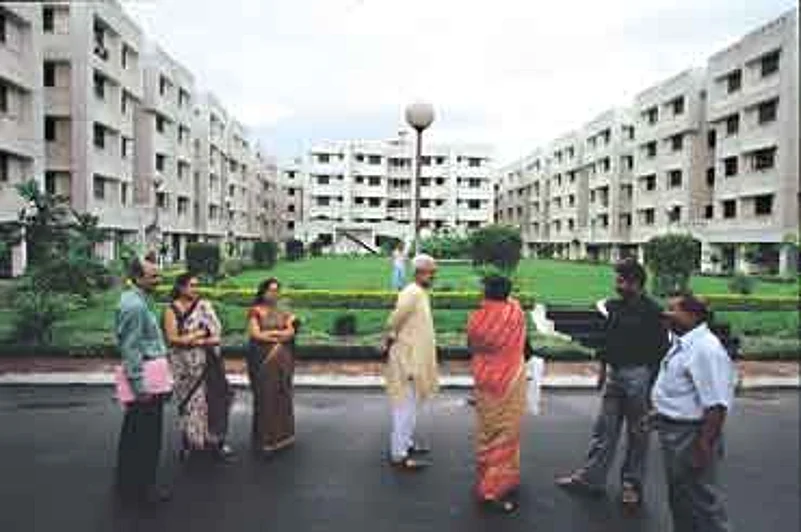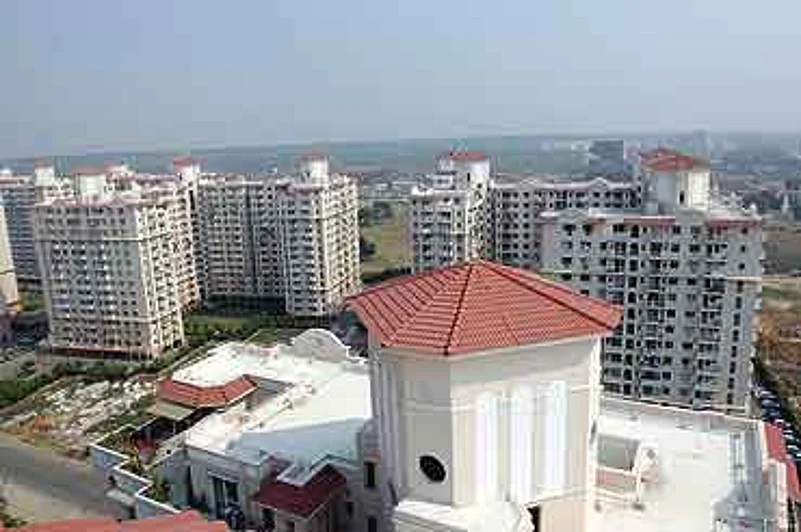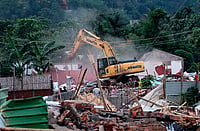In 2003, Ekta and Nikhil paid Rs 12,500 per sq ft for their sprawling four-bedroom, five-bathroom apartment in Jolly Maker III at Mumbai's Cuffe Parade. The going rate now for it is Rs 21,000 per sq ft.
Property prices in Shivalik Nagar, an industrial estate located 7 km from Haridwar, have gone up five to ten times in the past two years.
Property prices in Mansa Devi Complex, located around the upcoming IT park in Panchkula, Haryana, have more than doubled in the past 12 months.
Velachery has emerged as Chennai's booming neighbourhood and prices have zoomed from Rs 1,000-1,500 per sq ft in April 2004 to around Rs 2,000 today.
In the last two years, while prices of built-up properties in key residential areas in Bangalore have risen by 30-50 per cent, the land rates have concurrently gone up by 60-80 per cent.
In Jaipur, prices have doubled in 18 months though experts say "nothing in the local economy warrants this".
Akshaya Kumar, CEO of realtors Colliers International, announces that "the party's on". He waxes optimistic: "If one has to make a call, we haven't seen the top of the market yet." He's not talking about the Sensex, which witnessed a major correction in the past few days. What he's referring to is the non-stop boom in real estate—across the country in both big and small cities—in the past two years. Obviously, there's mixed reactions among the consumers. The lucky ones, who purchased properties a year ago, are elated, but those hunting for property today have seen prices rise beyond their budgets.
It's not the metros like Mumbai, Bangalore or Delhi that are leading this rush. It's the hitherto staid—at least in terms of property prices—cities which have emerged as the leaders. Hyderabad, which was never on the realtors' radar and was one of the cheapest markets in India, is now buzzing. Chennai, a plodder, will witness growth in commercial space over the next 12 months that'll be more than what's been seen in the last 10 years. Jaipur, Bhubaneshwar and Chandigarh have turned out to be pleasant surprises with prices doubling in the last 12-18 months. Even conservative consumers in Calcutta are willing to pay more.
As prices soar in the cities, the action is shifting to the suburbs and satellite towns. Prices in Delhi's neighbouring town, Gurgaon, have risen by 40 per cent in the last 12 months. In Noida and Indirapuram, Delhi's eastern neighbourhoods, they have more than doubled in the same period. "A year ago, the going rate was Rs 1,200 per sq ft of land. Now, it's Rs 2,600 and is likely to cross Rs 3,000 in the next six months as there's too much demand," says Pathak, an Indirapuram resident. Two years ago, the Mumbai-based Hiranandani group sold 0.5 million sq ft of residential space in Thane, which doubled to one million sq ft in 2004.
"If you are looking at real estate as an investor in Chennai, you shouldn't invest in known areas like T. Nagar. You should look at the IT corridor along the Old Mahabalipuram Road, where a six-lane expressway is coming up," says Sridhar Varadaraj of the California-registered Hanu Reddy Realty. Since October 2004, prices in Ranga Reddy Gardens, Neelangarai, about 20 km from Chennai, have doubled. The upcoming Sahara City project near Chennai's Avadi-Poonamallee bypass that leads to Bangalore has also resulted in skyrocketing prices. A piece of land measuring 2,400 sq ft that could have been purchased for Rs 2-3 lakh last year costs Rs 20-25 lakh today.
A similar story is playing out in the smaller state capitals like Chandigarh.Its satellite towns—Panchkula and Mohali—have seen a 40-50 per cent hike in property prices in the last 12 months.Zirakpur, once a dusty way station on the Chandigarh-Ambala road, is now teeming with developers building countless housing units, and cutting up agricultural land to apply for permissions to develop them. Ditto for areas like Kharar and Kurali, located on the outskirts of Mohali. A three-bedroom flat which was available for Rs 20-25 lakh a year ago in Panchkula's Sector 20 is being sold for Rs 35-45 lakh.
Sanjay Verma, joint MD of realty firm Cushman & Wakefield, believes the suburban model of development is common to most metros and big cities. "It's a long-term story and, in the coming years, the suburbs and satellite towns will grow faster than the main cities as the former have more space and potential for growth," he explains. To cite an example, Gurgaon, at full capacity, can house an alarming 4-5 million people, as against its current population of one million.

So, what's forcing real estate prices to go up, up and away? "The (residential) demand has been fuelled by increased availability of cheap capital, coupled with an improvement in the job market and income levels," sums up Anshuman Magazine, MD, C.B. Richard Ellis, a consultancy firm. The housing loan segment has witnessed a frenetic growth of over 30 per cent in the last three years. Overall disbursements by various banks crossed the Rs 65,000 crore mark in 2004-05. "What we used to disburse in a year in the mid-1990s, we do in a month now," explains Renu Sood Karnad, executive director, HDFC. Colliers' estimates show that while only one in 50 properties were purchased on mortgages in 1996, the ratio is seven out of 10 now.
Add to this the fact that the profile of a home owner has changed considerably over the past few years. Prakash Shah, senior VP, Hiranandani group, says the average age of the buyer has come down. "It used to be 50-55 years earlier. It has come down to 25-35 years (those buying in Thane) and 30-45 years (in Mumbai's Powai area)," he explains. Hanu Reddy's Varadaraj talks about how several double-income families with high-paying jobs are buying flats, reselling them two years later, earning attractive returns, and reinvesting in larger flats. "I have helped several couples do this in the past two years by buying a flat for Rs 20 lakh, selling it for Rs 25 lakh, and reinvesting the money in a larger house costing Rs 45 lakh," he admits.
Young buyers come with a different mindset. "They think differently; they don't mind taking a mortgage to buy a house," reveals Shah. Adds Karnad, "They want to enjoy now, pay later." This is probably why, as Colliers' Kumar points out, people in their late 20s wish to acquire long-term assets early in life. The new, young owners tend to have greater aspirations. Therefore, real estate developers are no longer selling a home; in fact, they are marketing a lifestyle. "It's not only the buildings. It's also about the neighbourhood, green surroundings, gardens, clubhouses, and hospitals, schools and offices located nearby," explains Shah.
But then the growth drivers in the commercial space segment have to be different. For, there's also a craze to develop office space in most cities. Analysts contend that Gurgaon will add 1.5 million sq ft of commercial space in the next six months, and Noida will see an addition of one million sq ft in the same period. In Bangalore, office space is coming up in the suburbs near the Outer Ring Road with one million sq ft under construction. In Chennai, nearly three million sq ft will be made available over the next 12 months in areas such as Velachery, Guindy and the Old Mahabalipuram Road.Hyderabad's Hi-tech city itself will shortly add 1.5 million sq ft.
The twin factors of IT/BPO and retail can explain most of this activity.The growth in both these sectors has resulted in an increasing demand for quality offices with larger floor plates, ample car parking areas and better facilities, but at affordable prices.The concentration of the IT/BPO sector in the National Capital Region (NCR) of Delhi, including Gurgaon and Noida, and in the Golden Triangle of Bangalore, Chennai and Hyderabad has helped displace Mumbai as the premier real estate market. "In the last 2-3 years, 75 per cent of the demand for commercial property in Delhi and adjoining areas has come from IT and BPO firms. This trend is likely to continue for the next 4-5 years," predicts Cushman & Wakefield's Verma.
In fact, Bangalore's commercial property market has been the most vibrant due to the IT/BPO factor, and accounted for nearly 40 per cent of the gross new demand for office spaces among seven most active property markets in India. In the last three years, over 1.5 lakh jobs have been created by the city's hi-tech sector and it has, therefore, attracted a regular inflow of immigrants. So is the case with other cities like Chennai and Hyderabad. Growing jobs in the BPO segment have also boosted the prices of residential properties. "Demand for high-end residential projects has been on the rise with increasing investments by senior (IT/BPO) executives," explains a real estate consultant. And the mid-level managers scout for houses in the suburbs. As IT and BPO firms move into smaller or less-expensive cities like Calcutta, Bhubaneshwar and Chandigarh, it pushes up property prices there.
Consider the example of the Singapore-based Ascendas, which has been in India since 1994 as an investor, developer and manager of commercial property and has close to 4 million sq ft of built-up area under its management. As India's largest foreign IT Park player, it hopes to double this over the next 18-24 months. "More than 1,000 mncs are our clients," says Jonathan Yap, south India head, Ascendas. "They give us a strong indication that they want to be in India, where the IT sector has grown by over 40 per cent per annum over the last five years. We go where our customers want to go," he adds. This explains why Ascendas has a strong presence in Bangalore, Chennai and Hyderabad and is now exploring opportunities in Calcutta, Pune and Noida.

Increasing consumerism has given a fillip to the retail market. And that's further increased the demand for mall spaces. Mumbai is likely to have 25 malls by end-2006. By 2007-end, the NCR region will have 18 million sq ft of mall space. In Chennai, mall development is taking place in areas like R.K. Salai and Nelson Manikam Road. And in Bangalore, retail development is shifting to areas like Whitefield and Koramangala, which are very close to the IT corridor. To take advantage of the current mall mania, developers build the malls first and later offload it to buyers. "Malls are not developed keeping the end-users in mind," agrees Ved Prakash Arya, joint MD, Kshitij Fund, India's first retail real estate fund launched by Pantaloon.
However, this is changing. Retail giants like the Mumbai-based Pantaloon are concerned about the availability of quality real estate. So, the firm, which has already developed 2.2 million sq ft, is thinking of adding another 5.5 million sq ft over the next two years. To finance such an expansion, it mobilised Rs 350 crore through the Kshitij Fund (a close-ended 7-year scheme). The money will be used to develop and sell retail space in tier-2 cities. Pantaloon is also planning to launch a dollar fund for foreign investors in the near future. ICICI and HDFC too have launched real estate funds, after an amendment of the SEBI (Venture Capital Funds) regulations last year that allowed venture capital funds to invest in real estate.
The retail sector can only boom in the near future once the government opens it up for foreign giants.In the case of real estate, FDI is allowed up to 100 per cent under the automatic route with restrictions on the minimum area that can be developed by foreigncompanies. "Last year, we spoke to one fund guy every six months. But over the last nine months, we've been talking to at least three fund managers a week. The dollars are out there sniffing, but they still haven't flowed significantly," feels Kumar. The reasons for the current lack of interest? An immature real-estate market, lack of transparency, an absence of reliable information and high transaction costs.

A number of city-specific reasons have also played their part in pushing up property prices. In Delhi, the metro and the upcoming Commonwealth Games, scheduled for 2010, have contributed to the demand. In Chandigarh and other cities in Punjab, returningNRIs, who decided to come back especially after 9/11, have started buying houses. Chennai is perceived to be a safe investment for most buyers and, says Varadaraj, "you can't lose money here". And in the next 36 months, Bangalore is expected to explode in terms of infrastructure like the planned international airport at Devanahalli and the upcoming Bangalore-Mysore expressway.
Still, there are a few question marks. A few analysts feel that speculative activity is rising and could force the real estate bubble to burst. The rbi, too, has asked banks and cooperatives to be careful about loans as the central bank has noticed that procedures are not being followed. HDFC's Karnad admits having seen loan applications for a third or a fourth house. "We are wary of it and are watching it closely. I still think the housing boom is a real one and there'll be no let up in prices in the next 5-7 years," she predicts. Kumar takes a more philosophical view and says that every boom has its winners and losers. "The last guy to realise what's happening will be left holding the baby." But, as of now, the party is rocking. We'll just have to wait and see who'll do the dishes when it's over.


























